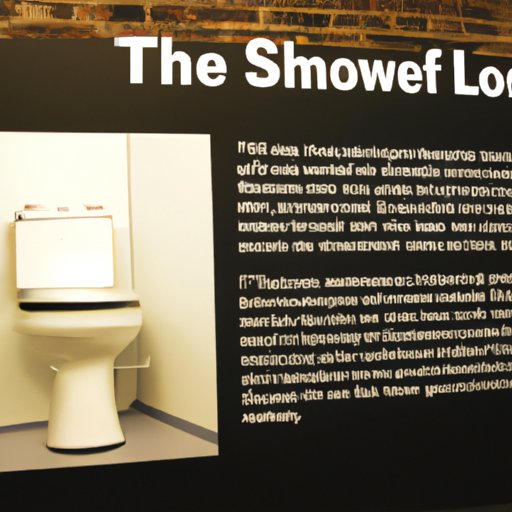Introduction: Exploring the Myth of Thomas Crapper: Did He Really Invent the Toilet?
In recent years, the name “Thomas Crapper” has become synonymous with the invention of the toilet. But did he really invent the modern toilet as we know it today? This article aims to explore the history and mythology surrounding the invention of the toilet, and to answer the question of whether or not Thomas Crapper was truly responsible for its creation.

A History Lesson: The Real Story Behind the Invention of the Toilet
The concept of a toilet is nothing new—in fact, it dates back thousands of years. Ancient civilizations had primitive forms of sanitation technology, such as the latrines used by the Romans, which were essentially holes in the ground. Other cultures developed primitive outhouses, which were essentially wooden boxes placed over a hole in the ground.
The first “modern” toilet was developed in 1596 by Sir John Harrington, a British courtier. His design featured a cistern and flushing mechanism, similar to the ones found in modern toilets. However, these early versions of the toilet were expensive and difficult to maintain, so they never gained widespread popularity.
It wasn’t until 1775 that the first successful flush toilet was invented by Alexander Cummings. This design featured a separate tank and bowl connected by a S-shaped pipe, allowing for a more efficient flushing system. This design was improved upon by Joseph Bramah in 1778, who added a valve to the tank to prevent water from overflowing.
By the mid-1800s, the modern flush toilet had been perfected. It was around this time that Thomas Crapper began his career as a plumber, though there is no evidence to suggest that he had any involvement in the invention of the toilet.
Debunking the Myth: Was Thomas Crapper Really the Father of the Toilet?
Despite the lack of evidence, many people believe that Thomas Crapper was responsible for the invention of the modern toilet. This is likely due to a number of misconceptions about him and his inventions. For starters, Crapper did not actually invent the toilet—he merely improved upon existing designs. He also didn’t invent the flushing mechanism, as this had already been developed by Cummings and Bramah.
Crapper did make some important contributions to the development of the modern toilet. He patented several improvements to the flushing mechanism, such as the “floating ballcock”, which allowed for a more efficient use of water. He also made other improvements to the design of the toilet, including the addition of a siphon jet to increase the power of the flush.
However, despite these improvements, there is no evidence to suggest that Crapper was involved in the actual invention of the modern toilet. That honor belongs to Cummings and Bramah, who developed the first successful designs for the flush toilet.

The Curious Case of Thomas Crapper: Separating Fact From Fiction
So why do so many people believe that Thomas Crapper invented the toilet? One explanation is that Crapper’s success as a plumber and inventor helped to spread the myth. He was highly respected in his field and was even appointed as the official plumber to King Edward VII and the royal family. This gave him a certain level of fame, which may have helped to perpetuate the myth.
Another possible explanation is that Crapper’s name was used as slang for the toilet. The term “crapper” became popular in the early 20th century and was likely derived from his name. This may have further contributed to the belief that he was the inventor of the toilet.
Regardless of the reasons behind the myth, there is no evidence to suggest that Thomas Crapper invented the modern toilet. While he did make some important contributions to the development of the toilet, the true credit for its invention belongs to Cummings and Bramah.
Unpacking the Toilet: Exploring the Evolution of Sanitation Technology
Today, the modern toilet is an essential part of everyday life. It consists of several components, including the bowl, tank, flushing mechanism, and trapway. The bowl is where the waste is deposited and then flushed away through the trapway. The tank contains the flush mechanism, which releases water into the bowl to flush away the waste. This tank is usually filled with water to allow for multiple flushes without having to refill the tank.
Over the years, toilet technology has evolved to become more efficient and user-friendly. Modern toilets are now equipped with features such as dual-flush mechanisms, heated seats, and even built-in bidets. These advances have made the toilet more comfortable and hygienic, making them an indispensable part of modern life.
Conclusion
This article has explored the history and mythology surrounding the invention of the toilet. Contrary to popular belief, Thomas Crapper did not invent the modern toilet—that honor belongs to Alexander Cummings and Joseph Bramah. While Crapper did make some improvements to the design of the toilet, his role in its invention was minor at best.
The modern toilet is now an essential part of everyday life, and its evolution has been driven by advances in sanitation technology. From primitive outhouses to modern toilets with built-in bidets, the toilet has come a long way in its centuries-long history.
Further research is needed to uncover the full story behind the invention of the toilet and the role of Thomas Crapper in its development. Until then, the truth behind this enduring legend will remain shrouded in mystery.
(Note: Is this article not meeting your expectations? Do you have knowledge or insights to share? Unlock new opportunities and expand your reach by joining our authors team. Click Registration to join us and share your expertise with our readers.)
